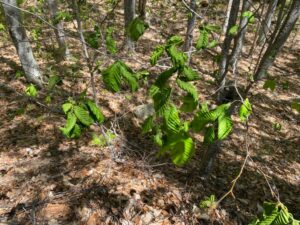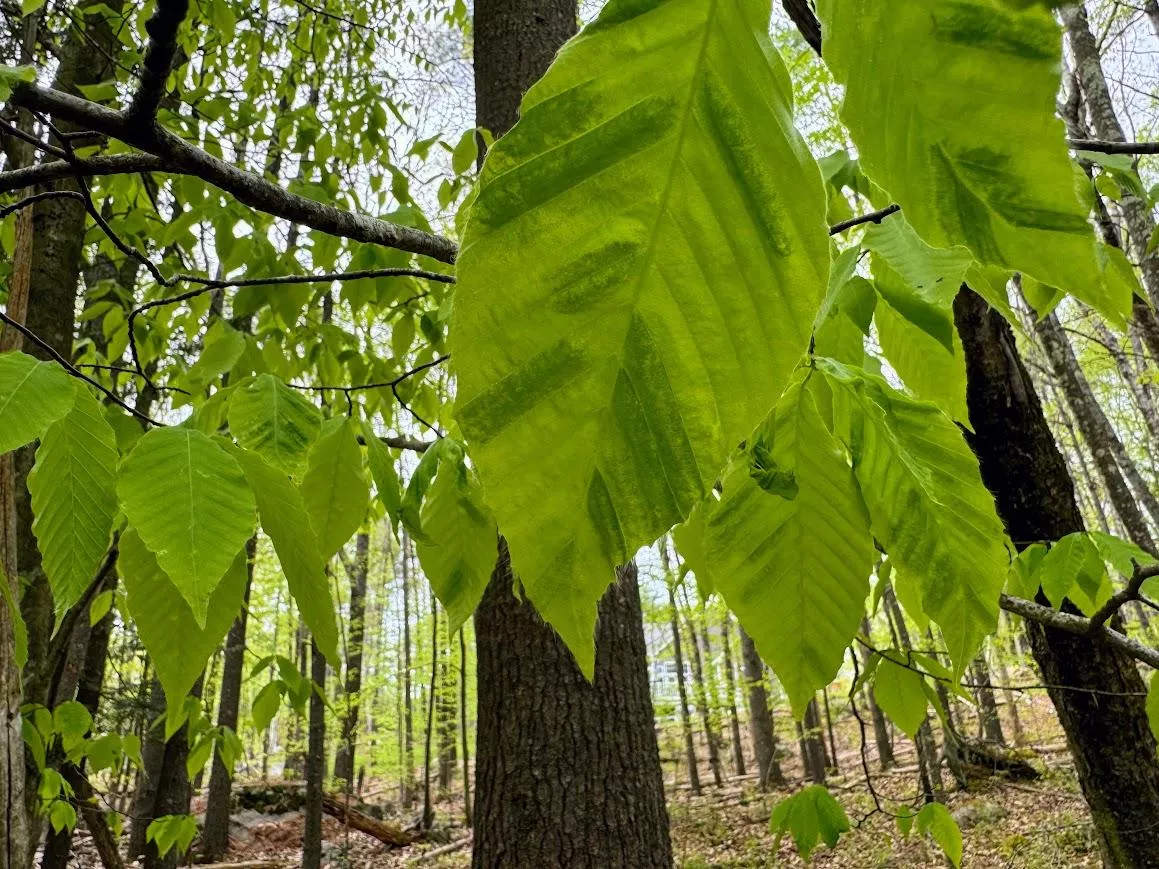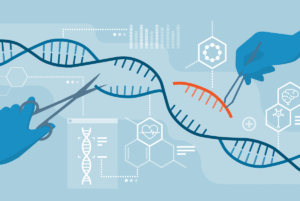While hiking in the past two years, I have increasingly noticed hundreds if not thousands of American Beech trees that look in very meager condition. All suffer from yellow, sagging leaves, many brown and wilted, countless of these Beech trees lay bare to the ground by the month of July. Behind this emotional and environmental disaster is an organism that may soon change the outlook of the Northeast forests for years to come – if not forever.
Introduction
Beech leaf disease is a disease caused as a result of the invasive nematode, Litylenchus crenatae mccannii, that feeds on the leaves of trees of the family Fagaceae. As it feeds on the leaves, it consumes many essential nutrients essential to photosynthesis and the upkeep of the leaf itself, leaving behind yellow and black bands on the leaves and a tree unable to photosynthesize energy. Being introduced in northeast Ohio in 2012, it has spread throughout the entirety of the mideast and northeast, spanning from Prince William County in Virginia to Aroostook County in northern Maine. Much of the nematode’s origin is unknown, due to its discouraging recent discovery, although it is likely believed to have been introduced from Japan where it foraged on Japanese Beech (Fagus Crenata). In their native region, the nematode left behind less adverse effects on the Beech specimens as opposed to the adverse effects on American Beech (Fagus Grandifolia) and European Beech (Fagus Sylvatica).

Image Credit: Coastal Mountains Land Trust
Devastation
Since the nematode’s introduction into the United States in 2011, it has spread to over 71 countries throughout the United States, including to the southern extremities of Canada. A recent report from Holden Forests & Garden documented that infected trees face a 30% mortality rate in the long term. Mortality rates vary from location to region, with areas where the disease is well established documenting mortality rates of up to 90%. This is significant, as American Beech (Fagus Grandifolia) constitutes around 11.1% basal area in the Appalachian Mountain range, going north from the state of Kentucky up to the border with Canada in Maine. Some areas, especially those at medium elevation above 2500 feet and in the Adirondack Mountains may constitute of over 30% American Beech in select plots. Local reliance of Beech trees by species such as Gray Squirrels (genus Sciurus), American Chipmunk (Tamias striatus), and avians like Blue Jays (Cyanocitta cristata), will force these species to forage for consumptionistic resources in other areas, potentially leading to a decline in such species. Another important note to the devastation are the economical perils of the nematode’s effect. The mass loss of American Beech trees in Ohio has resulted in an approximate loss of $225 million in timber sales, as well as hefty financial costs for homeowners. A survey conducted in 2018 in Halifax, Nova Scotia, reported removal costs of dying Beech trees at an average cost of nearly $2,000 per resident. The presence of Beech leaf disease just adds to the litany of invasive diseases affecting Beech trees, including Beech Bark Disease, Beech Bark Canker, and the European Beech Leaf Weevil (Orchestes fagi). However, Beech Leaf Diseases’ rapid spread may lead to it becoming the American Beech’s most dangerous and deadly foe yet.
Future
The major issue with combating Beech Leaf Disease and its etiology is that there is no major cure for affected forests, leading homeowners and environmental scientists to try to save select areas on a one-by-one basis. As of now, Penn State notes that preventing the spread of the disease can be achieved by limiting the spread of the nematode itself. This may be attained by not transporting wood or natural debris over distances longer than 50 miles, thus adhering to local firewood regulations, and cleaning materials that may have been in contact with saplings and vegetation, such as spades, shovels and other tools. But for now, there is no standard method nor system of preventing the spread and death of Beech trees. If the current trend of the spread continues, scientists project that forest compositions will rapidly be altered due to the nonexistence of the American Beech. Others point out that climate change and weather patterns may influence the spread and viability of the nematode that causes the disease. Though the extinction or disappearance of the species is unlikely, the case may be similar to that of the Emerald Ash Borer (Agrilus planipennis) which is estimated to put nearly 8 billion Ash trees at risk. As this disease continues to wreak havoc in our forests, we can all help by staying on top of new research and information, so we can all be ready to slow down the destruction of our prized northern woodlands.
Works Cited
“Beech Leaf Disease.” Extension.psu.edu, extension.psu.edu/beech-leaf-disease.
“Beech Leaf Disease.” Invasive Species Centre, www.invasivespeciescentre.ca/invasive-species/meet-the-species/invasive-pathogens/beech-leaf-disease/.
“Beech Leaf Disease : Landscape : Center for Agriculture, Food, and the Environment at UMass Amherst.” Center for Agriculture, Food, and the Environment at UMass Amherst, 26 Mar. 2025, www.umass.edu/agriculture-food-environment/landscape/fact-sheets/beech-leaf-disease.
“Beech Leaf Disease – Coastal Mountains Land Trust.” Coastalmountains.org, 2023, www.coastalmountains.org/nature_now/beech-leaf-disease-a-new-threat-to-the-ecological-health-of-our-maine-woodlands/. Accessed 30 Sept. 2025.
“Beech Leaf Disease: An Emerging Forest Threat in Eastern U.S.” US Forest Service, 2023, www.fs.usda.gov/inside-fs/delivering-mission/sustain/beech-leaf-disease-emerging-forest-threat-eastern-us.
Campbell, Faith. “Beech Leaf Disease – Don’t Move Firewood.” Don’t Move Firewood, Aug. 2019, www.dontmovefirewood.org/pest_pathogen/beech-leaf-disease/.
Roach, Margaret. “What to Know about Beech Leaf Disease: How It Spreads and Ways to Reduce Symptoms.” The New York Times, 13 Aug. 2025, www.nytimes.com/2025/08/13/realestate/beech-leaf-disease.html.
The. “Beech Trees Are Dying, and Nobody’s Sure Why.” Beech Trees Are Dying, and Nobody’s Sure Why , The Ohio State University, 9 Jan. 2019, news.osu.edu/beech-trees-are-dying-and-nobodys-sure-why/. Accessed 30 Sept. 2025.
Tubbs, Carl, and David Houston. “Fagus Grandifolia E H Rh.” Usda.gov, 2019, www.srs.fs.usda.gov/pubs/misc/ag_654/volume_2/fagus/grandifolia.htm.
Wikipedia Contributors. “Beech Leaf Disease.” Wikipedia, Wikimedia Foundation, 28 June 2025.






